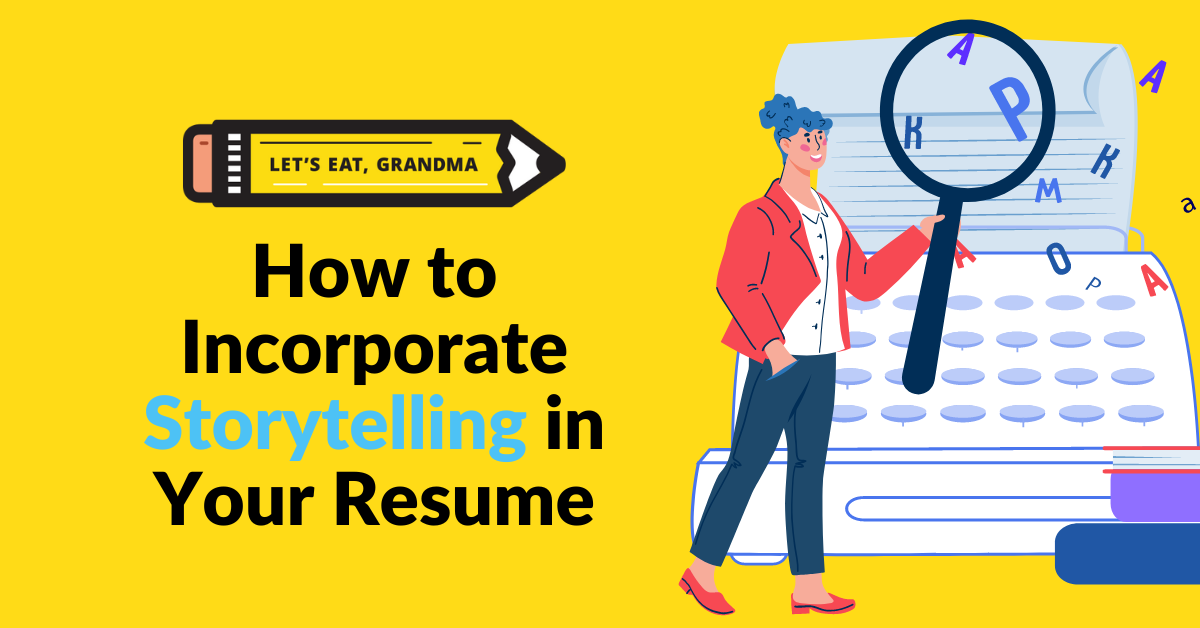How to Incorporate Storytelling in a Resume

A resume is more than a list of experiences and skills–it’s a marketing document. Learn how to boost your hiring potential through storytelling in your resume!
By: Reem Abouemera | Contributor for Let’s Eat, Grandma
One day, a young job seeker, James, went to a career fair. He took along an impeccably formatted resume, listing all of his qualifications and experiences chronologically. He thought he had the perfect resume – and waited eagerly after handing it to each potential employer.
But he didn’t get any callbacks.
Ready for more job search help?
Sign up for a free Senior Writer Resume Critique to see what's holding you back from landing interviews. One of our top professional resume writers will give you personalized feedback on the top 3 items you can improve based on our expert practices!

Presenting your accomplishments in a story makes them more relatable and memorable. Photo by Matias North on Unsplash
James was baffled. He had followed all the “rules” of resume writing, so why wasn’t anyone interested in hiring him? And what made it even worse was that some of his friends, who didn’t have nearly as much experience as him, were getting jobs left and right.
He asked one of his friends if he could see her resume.
When he looked it over, he finally understood what he had been doing wrong. Unlike his resume, which was a list of facts and dates, her resume told a story. It detailed her journey from an intern to a full-time employee and how she made an impact at each company she worked for.
He was taken aback by how powerful a story could be. And he realized that if he wanted to get hired, he would need to start telling his own.
Why You Should Use Storytelling in Your Resume
Technically, James didn’t do anything wrong.
His resume was formatted correctly and included all the relevant information for the job he wanted. But what it lacked was personality – and that’s something that a lot of job seekers overlook.
While it’s important to list your experiences and skills on your resume, what really matters is how you present them. Are they just a list of boring facts, or do they tell a story that shows why you’re the perfect candidate for the job?
Think about it from the employer’s perspective. They’ve probably seen hundreds, if not thousands, of resumes at this point. So what’s going to make yours stand out?
If you can tell a captivating story highlighting your best qualities and accomplishments, you’re more likely to pique their interest and land an interview. But if your resume is just a list of facts and dates, you’ll likely blend in with the rest of the candidates.
How to Use Storytelling in Your Resume

Each bullet point should be a mini story that details a specific accomplishment. Photo by Andrew Neel on Unsplash
So, are we talking about a long, drawn-out, “once upon a time” kind of story? Of course not. But you should remember that implied stories run throughout your resume. If they’re well-written, they’ll detail your journey from where you are now to where you want to be in the future. Here’s how:
Use Bullet Points to Tell Mini-Stories About Your Accomplishments
If you want to incorporate storytelling into your resume, one of the best ways is through your bullet points. Each bullet point should be its own mini-story that details a specific accomplishment.
Let’s say you’re applying for a job as a content writer. You have two routes to take:
Boring: Wrote blog posts for XYZ Company.
Better: Wrote engaging, SEO-optimized blog posts for XYZ Company that increased traffic to the website by 20% and received 500+ social shares.
The first is a list of boring facts that typically wouldn’t impress an employer. The second is a mini-story that highlights a specific accomplishment and paints you in a positive light.
It’s important to remember that your goal with each bullet point is to show, not tell. Instead of simply listing your responsibilities, focus on sharing quantifiable accomplishments that show how you made an impact at your previous job.
Use the CAR Technique (Challenge-Action-Result)
While the CAR Technique is typically used for behavioral interviews, you can definitely apply it to your resume. CAR stands for:
- Challenge: The problem or goal you were facing in your job.
- Action: The specific steps you took to solve the problem or achieve the goal.
- Result: The positive outcome of your actions.
When done right, this resume storytelling technique takes the employer on a journey from the problem to the solution, giving them a better understanding of your skills and abilities. And best of all, it does it in a way that’s easy to follow.
Here’s an example from a resume of someone applying for a job as a sales manager:
Before: Led a team of 10 salespeople.
After: Led a team of 10 salespeople to hit their quarterly quotas for the first time in 3 years by implementing a new sales strategy.
Here, the implied challenge was that the sales team wasn’t meeting their quotas for the past 3 years. The action was that the candidate implemented a new sales strategy. And the result was that the team hit their quotas for the first time in 3 years.
Similarly, here’s an example from a resume of someone applying for a job as a marketing coordinator:
Before: Wrote and designed weekly email newsletters.
After: Wrote and designed weekly email newsletters that increased click-through rates by 15%.
The implied challenge, in this case, was to increase click-through rates for the email newsletters. The action was writing and designing them in a certain way. And the result was a 15% increase in click-through rates.
In both cases, the “after” examples are much more effective because they show the employer what you’re capable of, rather than just telling them your job duties. They demonstrate that you’re a problem-solver who gets results, which is exactly the type of employee employers are looking for.
Storytelling Outside of Your Resume

A good cover letter tells the story of your career and how it has prepared you for the job you’re applying for.Photo by Nasik Lababan on Unsplash
Stories work wonders wherever they’re used, so don’t limit yourself to your resume. You can use them in other places, like your cover letter and LinkedIn profile.
Cover Letter
Your cover letter is one of the best places to draw out your stories even more. After all, you have more room for storytelling than you do on your resume, so take advantage of it! Plus, since you typically won’t use bullet points in your cover letter (or will use very few), it’s easier to write in a narrative style and follow the CAR Technique.
Here’s an example of how you might use the CAR Technique in your cover letter:
Soon after my promotion to Regional Manager at X Company, my supervisor handed me a report that showed our satisfaction scores had dipped below the company average. Specifically, it was due to our response times, which were averaging around 45 minutes. I knew we had to act fast to turn things around, so I created a new process for handling customer inquiries that shortened response times to under 30 minutes, held weekly team meetings to keep everyone updated on our progress and address any issues that arose, and implemented a customer satisfaction survey to get feedback on our performance. Thanks to the new process I put in place, we brought our satisfaction scores back up to the company average within two months. And within six months, my team was consistently ranking above average.
This is just a brief example, but you can see the trail of breadcrumbs it lays out for the employer, leading them from the problem to the solution. Sharing the whole story of your quantifiable results with them makes it easier to see the value you bring to the table.
Linkedin About Me Section
Your LinkedIn profile (specifically the About Me section) is another great place to share stories about your professional accomplishments. In fact, it’s a great place to share just about anything that’s relevant to your career!
When writing your About Me section, don’t just regurgitate your resume. This is your chance to add some personality and give employers a more well-rounded view of who you are.
Really hone in on what makes you unique, your values, and what drives you. You can use storytelling to go a little deeper than you could in the resume and cover letter: Think about challenges you’ve overcome, little moments you’re proud of, even how your job relates to your personal life. The key is to paint a picture of who you are as a person, and stories are the perfect way to do that.
In fact, studies have shown that people are 22 times more likely to remember a story than they are to remember facts and figures. So if you want employers to really remember you, sharing stories is the way to go!
Final Words
Too often, we forget that resumes and other job search documents are meant to be read by humans, not robots. If you remember that, it’ll be easier to write in an engaging and informative way.
And when in doubt, just remember to come back to this focus on storytelling in your resume and cover letter. A well-crafted story can make all the difference in whether or not you get your foot in the door. And, after all, they’re the most genuine representation of who you are as a professional. So why not use them to your advantage?
Need help putting your stories into words? Check out our resume writing services and get matched with a professional resume writer who can help you tell your story in the best way possible.
Ready for more job search help?
Sign up for a free Senior Writer Resume Critique to see what's holding you back from landing interviews. One of our top professional resume writers will give you personalized feedback on the top 3 items you can improve based on our expert practices!
